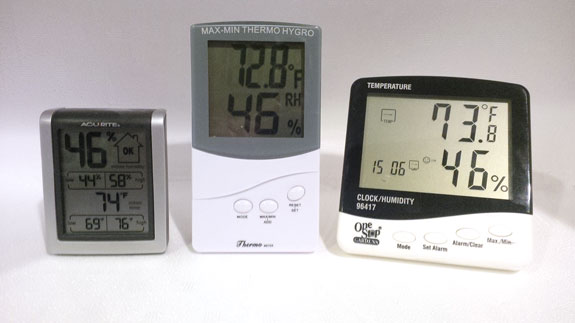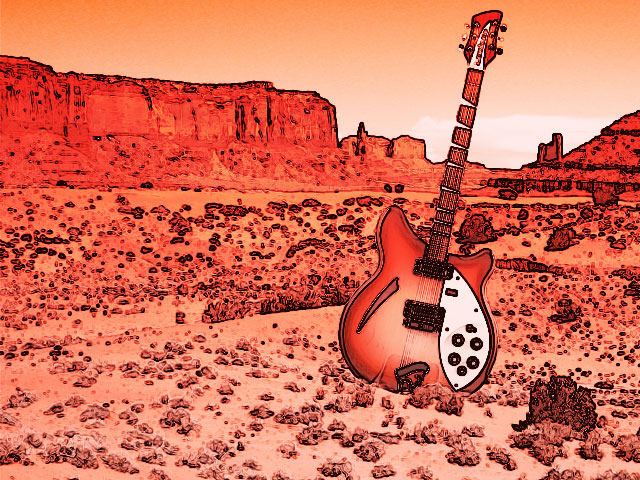- Published Jun 7, 2013 in Gear Garage
Wooden instruments can be finicky, especially when the temperature and humidity are at their most extreme. But with some inexpensive tools and a little maintenance, you can easily protect your investment.
If you own any wooden musical instruments, one of the most important accessories to have is a hygrometer. Not to be confused with a hydrometer, which measures gravity, a hygrometer measures the level of humidity or amount of moisture in the air.
Have you ever wondered why your guitar seems to go out of tune during temperature fluctuations and changes in the weather? Why do outdoor summer gigs result in the frequent need for re-tuning? Is your piano going out of tune during certain seasons? It’s the wood breathing, and adapting to the temperature and humidity levels.
A word or two about humidity.
There are three main measurements of humidity: absolute, relative and specific. Absolute humidity is the water content of air. Relative humidity, which is expressed as a percentage, measures the current absolute humidity relative to the saturation point for that temperature. Specific humidity is a ratio of the water vapor content of the mixture to the total air content on a mass basis. Warm air can possess more water vapor (moisture) than cold air, so with the same amount of absolute/specific humidity, air will have a higher relative humidity if the air is cooler, and a lower relative humidity if the air is warmer.
The reason it is important to know the relative humidity of a room is because wood holds moisture. Wood and wooden instruments “breathe”. An increase in humidity causes the wood to swell and expand, a decrease causes the wood to shrink and contract. A certain degree of this breathing is normal. However, extreme and/or quick variations in humidity (and temperature), can wreak havoc with wood.
Get thee a hygrometer.
Most hygrometers will display the current room temperature and relative humidity. For most guitars, the desired range is at a room temperature of 65-75 degrees F, with 45-55% relative humidity. Pianos are in the same range.
The main goal is to keep temperatures as stable as possible and keep the relative humidity within that ideal range. If you fall outside of the ideal range, there is no cause for panic. In fact, I see the levels in my studio sometimes reach 70% which means the wood is holding a decent amount of moisture and is swelling. This doesn’t bother me and the A/C corrects it as long as it is not overdone.
I am more concerned during the winter months when the forced air heat sometimes takes the humidity level down to a dry 25%. This means the wood is shrinking and not holding much moisture. This is often what causes cracking—perhaps even more so than fairly normal fluctuations in temp and humidity.
Most of the hygrometers I’ve purchased are inexpensive and self-calibrating. There are tons of choices online. Try to get a decent one in the $15-30 dollar range. I recently purchased a bunch in the $6 range which had been imported and 2 of them did not work when they arrived.

Some hygrometers are more accurate than others. The reading can vary by 5% or so. Placing a few together in your studio can help you peg their accuracy.
Your fight against moisture.
There is no need to panic when readings fall outside of your desired range. You have a fair amount of time before the instruments adapt to their environment.
Here are some tips to remedy readings outside of the desired range:
- If the reading is lower than 40%, then the moisture needs to be increased by utilizing a room humidifier which adds moisture to the air.
- If the reading is higher than 70%, the moisture needs to be reduced by utilizing air conditioning or a de-humidifier.
- Make sure to keep you instruments stored in their cases and stored away from any forced air, vents, etc.
About that piano of yours.
If you have a piano, you should consider the Piano Life Saver System by Dampp-Chaser Corp (around $230 installed). The one I have consists of two dehumidifier bars and a humidistat that automatically turns the unit on when the humidity level gets too high. This can be installed underneath the piano and requires no maintenance—it only needs to be plugged in. There is also a system that allows you to manually add water when the humidity is too low.
Keeping some inexpensive hygrometers around your musical instruments will help keep them in tune, and keep them happy and protect your investment.
To quote from my favorite comedian, Steven Wright: “For my birthday I received a humidifier and a dehumidifier. I put them in the same room and let them fight it out.”

